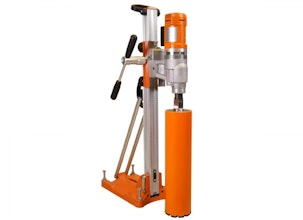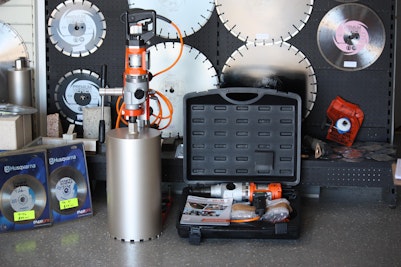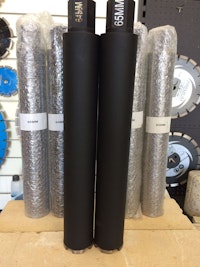Core Drilling Tips:
- You are not drilling a hole, you are grinding it. So it will take longer compared to using an SDS type percussion drill bits.
- For operator safety, most manufacturers recommend drilling over 67mm be done with the drill mounted in a stand.
- If the drilling is slow, the barrel may have glazed up. Redress the bit by reducing the water by half for a few minutes, until the water exiting the hole is really muddy. A bit of Ajax or clean builders sand down the hole can also have the same effect - run the drill at a slower speed, with reduced downwards pressure, so that an abrasive paste forms that will sharpen the segments . Or drill into an abrasive material like limestone, a cinder block or similar. Other operators swear by turning the barrel upside down and giving each segment a firm whack on the cutting edge with a piece of reo bar.
- Ensure there are no gas, power or water lines or any other issues where you are going to drill
- Never stand on a rig to hold it down, as this causes a 'ribbing' effect on the core, and the bit will eventually bind up in the hole
- Always turn on the water (always use clean water) before turning on the motor. Otherwise the water jacket seals on the drill can overheat, which will cause them to leak.
- For best results, apply water until the slurry looks like coffee made with a lot of milk. Too much water flow washes away the abrasive slurry which is needed to keep wearing away the segment and keep fresh diamonds exposed. Too little water can cause the diamond segments to overheat
- Do not use the overload protection as on/off switch - they are not designed as a switch, and when it fails it will not be warranty
- Use only heavy duty (2.5 mm2 or thicker) extension cords and keep them as short as possible
- When cutting steel, the slurry usually changes colour (usually to gray), or the drill motor speed drops. Drop the motor speed down and relax pressure by about 1/3. If you don't, the segments may overheat and bend inwards (occasionally outwards), and stop cutting. The barrel may also crack. Some operators reduce water after exiting the steel to redress the blade again, but don't forget to turn the water up again afterwards.
- Similarly, if you are drilling concrete with a high strength (or MPA), or with very hard aggregate in it, the bit may glaze up and need redressing. Do this by reducing the water by half for a few minutes, or by drilling into an abrasive material like limestone, a cinder block or similar. A bit of Ajax down the hole can also have the same effect.
- Limestone/asphalt and concrete barrels are not really interchangeable. But on a one off hole, a concrete barrel may do the job, but it will wear faster and may bind up.
Limestone segments are harder because of the abrasive nature of the material.
They are also wider to allow for an increased barrel clearance. This is because limestone dust is coarser than concrete dust, and will clog the barrel to hole clearance, causing binding.
Limestone barrels will work on softer concrete, but struggle with the steel reinforcement. - Be aware, no two coring jobs are ever the exactly the same. Variables include (but are not limited to) – what age is the concrete, what hardness and size of stone was used, the quantity and type of chemicals added to produce harder MPA's, how much steel reinforcing rod will be drilled etc.
- Barrels should last 10-15m per core bit, but may vary a lot, depending on bond of barrel, hardness of concrete, amount of steel, power of drill, amount of water used, experience of operator, etc
- If your 127mm barrel binds in limestone, United Diamond Tools have a limestone barrel specifically designed to reduce binding.
I also sell 127mm barrels for concrete, granite and laterite. - When removing the bit, turn the water down and back the bit out while the drill motor is still running.
- The driller's experience in deep coring is essential. The slurry from the cutting of asphalt or concrete is distinct and consistent. As soon as the core barrel cuts through the bottom of the asphalt or concrete into the road base, the slurry coming up to the surface will look different. Watch for the change, and then you will know you are through.
- Waterproof grease on the drill spindle thread will make bit changing easier.
- If excessive vibration or 'snatching' at the core barrel is detected – stop, remove the core drill, remove the core and investigate. Remove any lose material, pieces of cut steel rod etc. When drilling brick walls, wall ties maybe encountered - remove them with pliers. Failure to fix these problems may result in segment damage or loss.
- If a diamond segment or part of the reinforcement breaks in the hole, do not drill the same hole with the same size bit - use a barrel 15-20mm bigger to over drill the hole.
- If the drill speed is too high, the diamond segment will skip over the grinding surface. This means the core barrel bond will not wear away to expose new diamonds and the cutting edge becomes blunt or glazed over
- On smaller diameter holes, there is a tendency for the core barrel to wander away from the true center. This is because there is no pilot drill system to lock the barrel in the drilling position. A piece of heavy timber is sometimes used (on the outbound rotational side) to steady the bit
- Drilling with diamonds (an abrasive technology), when compared to SDS percussive drilling, is the slowest of all cutting methods. Concrete drilling with embedded steel can take many times longer. Have realistic expectations as to the time it requires.
- If your internal 1/2" thread is rusted, and won't clean up, you can still use 1/2" bits by buying a 1 1/4"UNC to 1/2" adaptor (cross over sub) from us. See them here.
- If coring horizontally near the ground, make sure the area is clear of water and debris. Or place cardboard or plywood underneath the drill to prevent stones, grit and slurry being sucked into the motor.
- Always clean and drain water out of the drill before putting it back in its case. Ensure the water tap is open. Always transport drill in case to prevent damage.
Core drill troubleshooting:
Motor not turning:
| Power point not working | Try another power point |
| Incorrect power | - Do not run off generators - Extension cords too long - Extension cord not heavy duty enough |
| Brushes | Check brushes not worn and moving freely |
| RCD not working | Replace by an electrician |
| Overload (if fitted) tripped out | Reset - may need to wait till drill cools |
| Damaged cable | Usually between RCD and drill, especially if wiggling cable with switch on gets drill to run - replace |
| Motor turning but no power | Clutch may need to be retightened to factory specifications. |
Power cables are often damaged by:
- Operator dragging drill by power cable
- Heating and cooling down frequently, causing cable to become brittle.
- Driving over cables
- Coiling cable tightly to fit back in drill box
For advanced operators:
- With conventional brush type motors, as the motor current rises from feed pressure, the RPM will drop. This causes a decrease in surface feet per minute (SFM), which slows the production rate of drilling. An amp meter can assist the operator in getting the most out of a drill motor by maintaining a more constant RPM or SFM. Drilling should not be carried out above the rated amp draw of the motor.
- An amp meter can also assist brush-less Induction type motors not to draw current until the overload protection device trips
- Need to drill dry for environmental reasons but only have a standard water-cooled core drill and bit? There have been cases of operators connecting up air to the drill instead of water, but this may not suit all applications, and air is not as efficient at cooling as water. It also may lead to damaged seals in the drill in prolonged use. But it may be ok for a small job.
- Be aware if using a vacuum assembly to anchor a core drill stand to a surface, the operator may risk injury if the vacuum pump fills with slurry, or the power goes off. This can cause loss of vacuum, which can result in the drill stand breaking free and falling, or rotating round the drill.
- The motor switch and handle must not be exposed to water (splash proof only) as it contains the electronic board. The air vents in the motor top hood are designed to deliver air cooling to the armature and no water or slurry must be allowed to enter. Do not place drill on ground till motor has fully stopped.
Removing cores:
Remove cores by using a cold chisel to "crack" the core away from the remaining concrete.
then you can:
- Use screwdrivers to lever out the segment (amatuer level).
- Drill anchor in (usually done before coring), screw in a bolt or similar, and lift out.
- Use the Golz chisel and lasso arrangement to lift core out.
- Use an old barrel with some divots punched in so it will grab the core and lift up (pro level)
Removing stuck barrels:
Barrels will jam or bind in holes due to:
- Insufficient segment clearance on inside and/or outside of barrel due to wear or cheap quality barrels.
- When bolting to any surface make sure your stand is plumb, and make sure the stand's adjustment feet are tight so they can't vibrate loose.
- When coring through steel always drop to the lowest speed possible. Raise and lower the drill motor multiple times until you have cored through any steel.
- Never undo the stand with the barrel in the hole.
- Clean out the core hole regularly.
- Don't try removing too long a slug
- Out of round barrel, usually caused by damage transport or removal of slugs
- Use sufficient water pressure to help flood the sediments up from deeper holes. Relieve the pressure on the core bit for a few minutes now and then.
To undo jammed barrels:
- You can over core a barrel if you get jammed up.
- Keep the stand bolted down. Use WD40 for lube or dishwasher liquid down the hole. Put a spanner on the back nut. Rock the carriage up and down while someone else rocks the barrel back and forth.
- Remove the stand and core drill, leaving the barrel. Use WD40 for lube or dishwasher liquid down the hole. Use a slide hammer or core puller. The barrel may lose a segment teeth but it'll come out.
- Alternatively, remove the drill and stand, and screw a rod of 1 1/4"UNC and a couple of nuts in to the barrel hole. Lock the 1 1/4"UNC nuts together so the rod can be turned. This should push the barrel up.
Trouble Shooting core barrel problems:
| Problem | Cause | Remedy |
| Segment bent over | Too much pressure by operator when cutting reo | Replace barrel, decrease pressure when cutting reo |
| Barrel binds in hole | Insufficient segment clearance on inside and/or outside of barrel due to wear or cheap quality | Replace barrel. More tips on jamming above. |
| Grit from coring gripping barrel | Clean out the core hole regularly, or increase water pressure | |
| Trying to core too deep in one go | Core in sections | |
| Not coring vertically | Use a stand, or core accurately using level bubble on drill. | |
| Excessive segment wear | Insufficient coolant | Check water lines, increase water |
| Speed too low | Increase the RPM inline with recommendations | |
| Too much motor power | Match machine power to barrel diameter | |
| Drill is vibrating | Fix drill rig down firmly. Check bearings, rollers etc. | |
| Wrong barrel for the job (ie too soft) | Select correct barrell to suit material being drilled | |
| Loss of Segment | Bit is too hard, causing barrel to bounce | Decrease drill speed, or use softer bond |
| Overheating | Increase water flow | |
| Drill and bit moved while drilling | Hold drill firmly, or mount drill on a stand | |
| Debris in hole, or loose reinforcement | Clean hole of rocks, reo fragments etc. Reduce RPM | |
| Drill rig set up not rigid enough | Tighten anchor or check vacuum pressure | |
| Core bit is hitting loose reo | Reduce RPM until reo is cut | |
| Segments crack | Bit is too hard | Decrease drill speed, or use softer bond |
| Drill not held rigidly | Hold drill firmly, or mount drill on a stand | |
| Barrel Cracking | Too much pressure by operator | Reduce pressure |
| Bit is too hard | Use softer bond | |
| Belled Barrel | Too much pressure by operator | Reduce pressure |
| Excessive wear on steel tube | Drill is vibrating | Fix drill rig down firmly. Check bearings, rollers etc. |
| Barrel is warped or not running true | Replace barrel | |
| Debris in hole | Such as parts of reo, gravel etc. Increase water to remove | |
| Barrel is not aligned to drill | Make sure barrel is aligned to drill spindle. | |
| Not drilling | Material too hard for barrel eg granite | Select a more suitable (usually softer) barrel |
| Excessive water | If clear water coming out, reduce flow till water is milky/cloudy. | |
| The bit is glazed up | De-glaze bit (see above) then re drill with more pressure | |
| Operating speed too high | Reduce speed | |
| Drill motor under powered | Match drilling diameter to motor power | |
| Too little pressure | Resharpen, the reuse with more pressure |
Core Drill Bits Speeds:
(These core drill speeds are suggested only. Always consult your drill manual for recommendations to suit your machine)
| Diameter mm | Drill speed |
| 8-29mm | 3,000RPM |
| 30-45mm | 1,500RPM |
| 46-65mm | 1,200RPM |
| 66-89mm | 900RPM |
| 90-125mm | 600RPM |
| 126-200mm | 450RPM |
| 201-400mm | 300RPM |
Disclaimer: the information on this website is provided in good faith and believed to be reliable and accurate at this time. However, the information is provided on the basis that the reader will be solely responsible for assessing the information and its veracity and usefulness. UDT shall in no way be liable, in negligence or howsoever, for any loss sustained or incurred by anyone relying on the information, even if such information is or turns out to be wrong, incomplete, out-of-date or misleading.



Address:
Unit 9, 84 Barberry Way
Bibra Lake WA 6163
Christmas 2025 Closure:
Close: Fri 19/12/25 at 3.30pm
Open: Tues 6/1/26 at 8.00am
Jan 2026 trading hours:
Tues, Wed & Thurs only, 8.00am to 4.00pm.
Normal trading after 3/2/26.
(ie Tues to Fri, 8.00am to 4.00pm)
